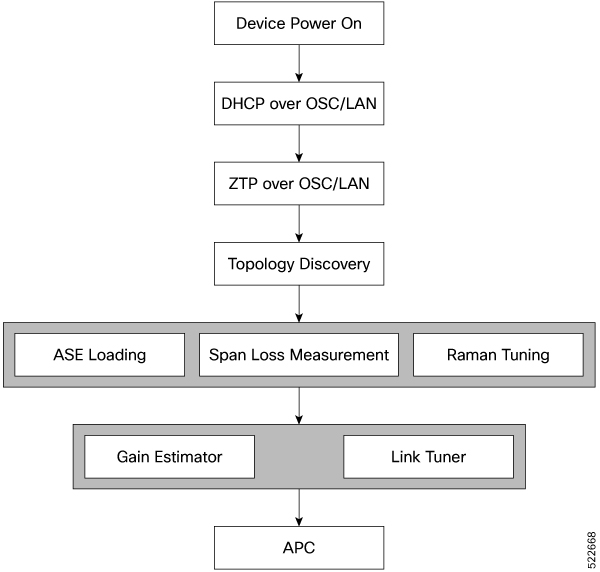Overview of Automatic Link Bring Up
You can bring up an NCS 1010 DWDM link without using any external tools. NCS 1010 measures optical parameters for all the spans at power-up. It then computes different setpoints for each of the spans to ensure optimal link performance for end-to-end traffic to pass through. The following optical applications enable Automatic Link Bring Up:
-
Span loss measurement
-
Gain Estimator
-
Link Tuner
-
Automatic Power Control
-
Raman Tuning
Automatic Link Bring Up uses the following user configurations if they are available:
-
Measured span loss
-
Fiber type
-
Spectral Density
-
Span length
Automatic Link Bring Up works under the following assumptions:
-
The fiber connections are proper. There are no fiber cuts or faulty connectors blocking link bring up.
-
OSC link comes up without need of Raman gain. If span length is high and NCS 1010 is not able to turn up OSC without Raman Gain, you must disable Raman tuning and manually configure Raman amplification.
You need Automatic Link Bring Up after physically installing your device and connecting the fibers as necessary. Automatic Link Bring Up process starts when you turn on a device. The new device that you turn on does not have any configuration on it. First, the device must join the network and get an IP address.
The NCS 1010 device uses DHCP to get an IP address. After receiving an IP address using DHCP, the device gets ZTP configuration file from the DHCP server or a separate ZTP server. Configure the DHCP server with the desired IP address and configuration file for each NCS1010 device you want to configure. The NCS 1010 uses the configuration file and configures itself.
In optical networks with long spans, it is not always practical for all nodes to have direct connectivity to a DHCP server. In such cases, the OLT node that has server connectivity acts as a DHCP relay and provides the next node with DHCP connectivity. The ILA node that connects to the OLT then acts as a DHCP relay for the next ILA node in the link. Each subsequent node then acts as a DHCP relay and provides DHCP connectivity to the adjacent nodes down the link. See Remote Node Management in NCS 1010 for more information. As this process completes, all nodes get network connectivity and receive the ZTP configuration files. ZTP allows you to provision the network device with day 0 configurations.
The ZTP configuration file must contain the following configurations:
-
Host configuration
-
DHCP relay configuration (only if there are nodes further down the link)
-
Interface configuration
-
OSPF configuration
-
SSH configuration
See Boot Using Zero Touch Provisioning for more information on configuring and using ZTP.
After ZTP configuration is complete, the NCS 1010 device uses OSPF to perform topology discovery. During topology discovery, each node finds out about its adjacent node and the entire topology. After discovering neighbor nodes, the device initiates span loss measurement. If the span is a Raman span, the device initiates Raman tuning. Simultaneously, the OLT begins ASE loading to load all the channels with noise.
After ASE loading, span loss measurement, and Raman tuning are complete, the NCS 1010 device initiates Startup Gain Estimation and Link tuner. Startup Gain Estimation sets the target gain and gain mode for the EDFA amplifier. Link tuner provides the target PSDs for the channels.
 Note |
Startup Gain Estimation analyses the span loss and sets the gain mode of the EDFA amplifier and provides the initial target gain for the amplifier. EDFA amplifiers are present in both OLT and ILA variants of NCS 1010. These EDFA amplifiers are variable-gain optical amplifiers capable of working at two different gain ranges or modes. The modes are normal mode and extended mode. Extended mode provides higher gain than the normal mode. Changing the gain mode of an amplifier is traffic impacting. Therefore, Automatic Power Correction (APC) is unable to change the gain mode of an amplifier. |
After Startup Gain Estimation and Link tuner operations are complete, the NCS 1010 initiates APC. APC uses the target PSDs that Link tuner sets and regulates the power output for all channels. Automatic Link Bring Up is complete and the optical link is up with all ASE loaded noise channels with the target PSDs set by link tuner. Create and configure optical cross connects to get traffic up and running on the link.
The following flowchart shows the sequence of the optical applications during automaticlink bring up.

The following example shows a sample ZTP configuration file with the minimum required configuration.
!! IOS XR Configuration
!
hostname ios
username cisco
group root-lr
group cisco-support
secret 10 $6$7motIAh93vG/I...$iM64ZfsZ5ciicdcsdsewHdEIvLTq0YEc1G1NMpauwJUiEnkV8LwMJUDZnnTkVj9RPgf4wffWJYelPN7jqiN3q/
dhcp ipv4
profile r1 relay
helper-address vrf default 10.33.0.51 giaddr 10.7.3.2
!
profile r2 relay
helper-address vrf default 10.33.0.51 giaddr 10.7.2.2
!
interface GigabitEthernet0/0/0/0 relay profile r2
interface GigabitEthernet0/0/0/2 relay profile r1
!
call-home
service active
contact smart-licensing
profile CiscoTAC-1
active
destination transport-method email disable
destination transport-method http
!
!
interface Loopback0
ipv4 address 10.3.3.13 255.255.255.255
!
interface GigabitEthernet0/0/0/0
ipv4 address 10.7.2.2 255.255.255.0
!
interface GigabitEthernet0/0/0/2
ipv4 address 10.7.3.2 255.255.255.0
!
router ospf 1
router-id 10.3.3.13
distribute link-state
nsf
network point-to-point
redistribute connected
area 0
interface Loopback0
!
interface GigabitEthernet0/0/0/0
!
interface GigabitEthernet0/0/0/2
!
!
!
ssh server v2
ssh server vrf default
ssh server netconf vrf default
!
end
Enable Automatic Link Bring Up
Use the following commands to enable automatic link bring up.
configure
optical-line-control
automatic-link-bringup
commit
end
Disable Automatic Link Bring Up
Use the following commands to disable automatic link bring up.
configure
optical-line-control
no automatic-link-bringup
commit
end
 Feedback
Feedback